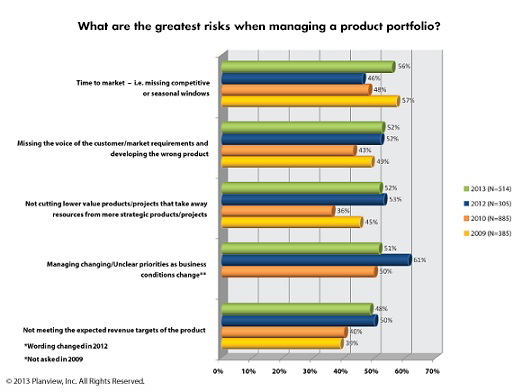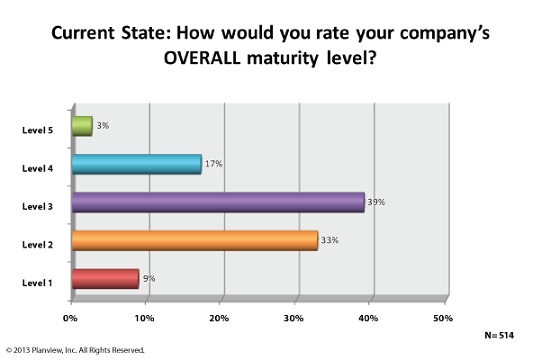
Findings from the Fourth Product Portfolio Management Benchmark Survey and a Roadmap to Sustainable Innovation
Imagine sailing in the World Cup race without a strategic plan or a map. It is a sport where speed is of the essence, decisions (and perhaps more importantly the timing of those decisions) are paramount, and team talents must be optimized at any moment. With competitors abound displaying their impressive spinnakers and advanced technology — only the risk takers advance. The will to win is apparent, yet without a strategy and a map, a team would drift into execution mode and lose the race.
This analogy comes alive in the takeaways from the Fourth Product Portfolio Management Benchmark Study. Since 2009, we’ve captured the state of product portfolio management at companies around the globe from a variety of industries. This year, due to trending information, and the addition of new analysis and questions, a more comprehensive picture has emerged portraying the challenges, facts, and missing elements needed to deliver timely innovation and high value product portfolios.
The Current State for Product Development
In the world of product development, the race is to speed new innovation to market and make it repeatable. The survey found that product development organizations face more pressure to deliver timely, on-target products but lack key elements to drive a programmatic, repeatable innovation program in line with company goals.
Drifting in Execution Mode
Survey participants indicated they are facing the same top pain points as those first reported, and are trending up: they have more work than people to do it, and cannot drive innovation fast enough. Talk about a difficult headwind! At the same time, their top reported risk of time to market is intensifying. They face mounting pressure to accelerate innovation, causing time to market to jump from the number five position in 2012 to the greatest risk conveyed by survey participants this year. The second highest areas of concern are developing the wrong products and not cutting lower value products and projects that take resources from more strategic ones.

The Missing Elements for Speeding Innovation
To avoid drifting, the survey highlighted four distinct missing elements that are the reasons behind the persistent and escalating pain points around product portfolios and pipelines, which can lead to critical mistakes in the creation and delivery of new products. They include:
- A Defined Pathway: Innovation is an outlier without an industry standard and systematic approach. Product leaders agree: For 45-70% of those surveyed (depending upon maturity level), innovation growth is imperative, but their companies lack a clear path on how to improve and develop in this area.
- Data: More than 80% of companies are supporting decision making with poor and/or hard to access data. This makes it difficult for leaders to make the tough decisions, such as what new initiatives to fund and which ones to kill.
- Strategic Alignment: More than half of the survey respondents indicated their product portfolios are not aligned well enough with company strategies and objectives, creating numerous pain points that include ineffective decision-making (53%).
- Culture: More than 70% reported that their leadership is averse to risk and equates killing products with failure. In fact, overall risk aversion is growing steadily. Too few are rewarded for taking calculated risks, which is the bedrock of innovation.
Benchmarking Innovation Management Maturity
As with many sports, such as World Cup sailing, excellence must be attained on a variety of fronts including the team (only top sailors need apply), the training and process (better be tight), and the boat (think new technology and tools).
For this year’s study, we asked participants to rank their company on the new Innovation Management Maturity Model™ across three core areas: people, processes and tools. Sound familiar to the sailing reference? At least 45% to 70% of organizations surveyed (dependent on maturity level) are looking to move up in maturity. They are just realizing that they need a roadmap and framework to understand their current state, where they aspire to be, and a roadmap and best practices to operationalize and embed innovation into the company. In other words, they need a destination and a compass. The model helps define a pathway to a sustainable innovation program, enabling product groups to compare their programs to the characteristics and best practices of other organizations. Here too, experience matters.

The survey showed that there was a distinct separation between the lowest maturity organizations and the remainder, with better use of tools as the only way to jump the chasm. Of these lower maturity companies, 61% admit they cannot effectively make decisions, and 44% are not even capturing data, signaling a need to leverage purpose-built technology. As in the World Cup analogy, technology and tools make a difference, and reliance upon spreadsheets and basic project tools will leave your team behind in the course.
Higher maturity organizations were found to be less risk-averse supported by the fact that they have more criteria, processes, and data in place to make hard decisions to “fail fast” — kill products that are not aligned to the company strategy and do not meet projected goals. They are also more likely to have access to accurate data to make these important decisions. More mature organizations are 30% more likely to have access to accurate data on demand than their lower maturity peers. Effective tools and processes make the difference because they enable organizations to take calculated risks and to be smarter, faster, and more agile to deliver innovation that beats the competition.
It is important to step back from execution mode and look at the big picture. Where does your product organization currently stand when it comes to innovation management maturity? What is the destination? How can you shore up maturity in terms of people, processes, and tools? Those companies that build in this edge rather than drifting in execution waters will be the winners.
If you haven’t already read it, please download the Fourth Product Portfolio Management Benchmark Study now. I’m interested in your input and questions! And if you want to assess your company on the Innovation Management Maturity Model and compare it to the industry standard benchmarks from the research, visit: Innovation Management Maturity Model™.




